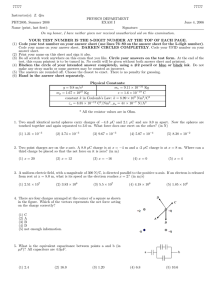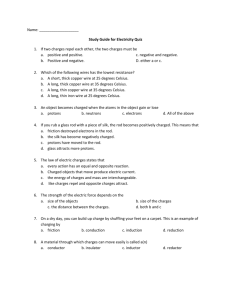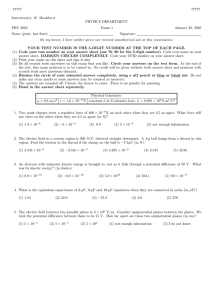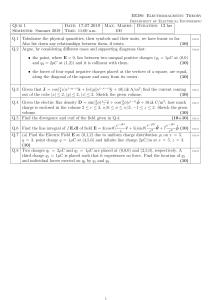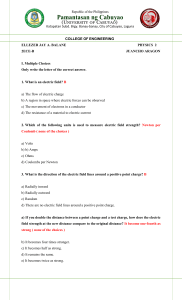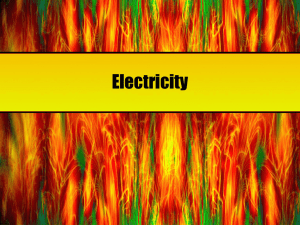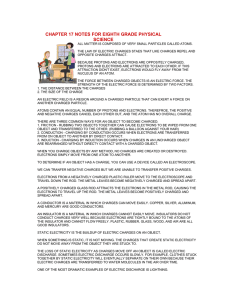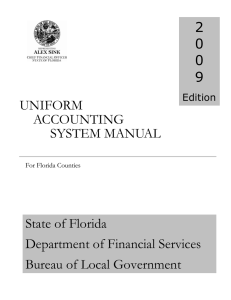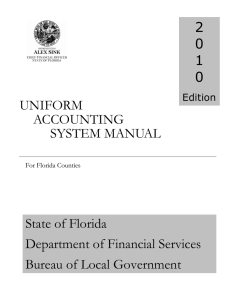77777 Instructor(s): PHYSICS DEPARTMENT PHY 2005, Spring 2008
advertisement
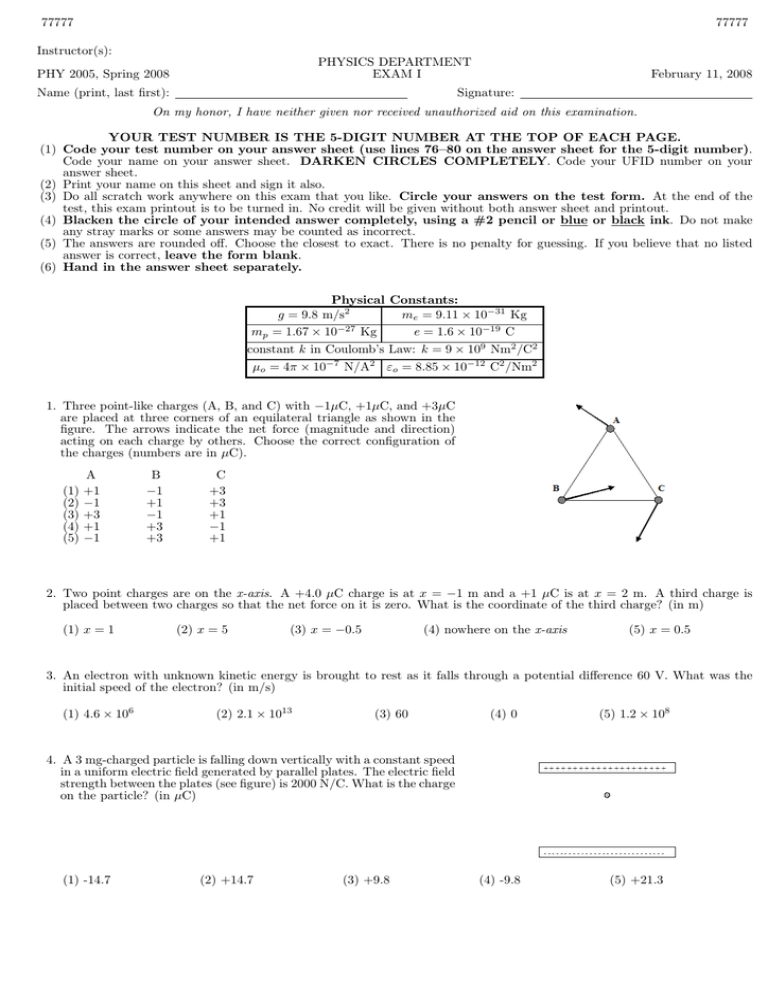
77777 77777 Instructor(s): PHYSICS DEPARTMENT EXAM I PHY 2005, Spring 2008 Name (print, last first): February 11, 2008 Signature: On my honor, I have neither given nor received unauthorized aid on this examination. YOUR TEST NUMBER IS THE 5-DIGIT NUMBER AT THE TOP OF EACH PAGE. (1) Code your test number on your answer sheet (use lines 76–80 on the answer sheet for the 5-digit number). Code your name on your answer sheet. DARKEN CIRCLES COMPLETELY. Code your UFID number on your answer sheet. (2) Print your name on this sheet and sign it also. (3) Do all scratch work anywhere on this exam that you like. Circle your answers on the test form. At the end of the test, this exam printout is to be turned in. No credit will be given without both answer sheet and printout. (4) Blacken the circle of your intended answer completely, using a #2 pencil or blue or black ink. Do not make any stray marks or some answers may be counted as incorrect. (5) The answers are rounded off. Choose the closest to exact. There is no penalty for guessing. If you believe that no listed answer is correct, leave the form blank. (6) Hand in the answer sheet separately. Physical Constants: g = 9.8 m/s2 me = 9.11 × 10−31 Kg mp = 1.67 × 10−27 Kg e = 1.6 × 10−19 C constant k in Coulomb’s Law: k = 9 × 109 Nm2 /C2 µo = 4π × 10−7 N/A2 εo = 8.85 × 10−12 C2 /Nm2 1. Three point-like charges (A, B, and C) with −1µC, +1µC, and +3µC are placed at three corners of an equilateral triangle as shown in the figure. The arrows indicate the net force (magnitude and direction) acting on each charge by others. Choose the correct configuration of the charges (numbers are in µC). (1) (2) (3) (4) (5) A +1 −1 +3 +1 −1 B −1 +1 −1 +3 +3 C +3 +3 +1 −1 +1 2. Two point charges are on the x-axis. A +4.0 µC charge is at x = −1 m and a +1 µC is at x = 2 m. A third charge is placed between two charges so that the net force on it is zero. What is the coordinate of the third charge? (in m) (1) x = 1 (2) x = 5 (3) x = −0.5 (4) nowhere on the x-axis (5) x = 0.5 3. An electron with unknown kinetic energy is brought to rest as it falls through a potential difference 60 V. What was the initial speed of the electron? (in m/s) (1) 4.6 × 106 (2) 2.1 × 1013 (3) 60 (4) 0 (5) 1.2 × 108 4. A 3 mg-charged particle is falling down vertically with a constant speed in a uniform electric field generated by parallel plates. The electric field strength between the plates (see figure) is 2000 N/C. What is the charge on the particle? (in µC) (1) -14.7 (2) +14.7 (3) +9.8 (4) -9.8 (5) +21.3 77777 77777 5. There are three capacitors with 7 µF, 3 µF, and 2 µF. They are connected in parallel across a 12 V battery. What is the amount of charge on the 3 µF capacitor? (1) 36 µC (2) 1 µC (3) 144 µC (4) 12 nC (5) 12 µC (4) 55 (5) 46 6. How many 60-W/120-V bulbs can be operated on a 20-A house circuit? (1) 39 (2) 60 (3) 50 7. In a uniform parallel electric field, a −3 mC point charge was carried from position A to D as shown in the figure. What is the electric potential difference between A and B? (1) 2595 V, higher at A (2) 3000 V, higher at A (3) 3000 V, higher at B (4) 1500 V, higher at B (5) 2595 V, higher at B 8. Refer to the above question. What is the change in electric potential energy for this process from A to D. (1) +3.3 J (2) −3.3 J (3) +5.7 J (4) −1.5 J (5) +20.2 J 9. A 6-A current is maintained in a simple circuit with a total resistance of 200 Ω. What net charge passes through any point in the circuit during a 1-minute interval? (in C) (1) 360 (2) 1200 (3) 60000 (4) 12000 (5) 157 10. A 9 V battery is connected across the ports A and B. How much current is flowing through the point C in the figure? (in A) (1) 1.5 (2) 0.6 (3) 0.67 (4) 1.67 (5) 16.0 11. Which is the correct loop equation for loop ABCDEFA in the circuit shown in the figure? (1) 7I1 − 15I3 = 10 (2) 7I2 + 10I3 = 6 (3) −7I1 + 9I3 = 2 (4) 7I1 − 12I2 − 3I3 = 4 (5) I1 + I3 = I2 77777 77777 12. A uniform electric field is set between two conducting plates as shown in the figure. Three charged particles with the same mass enter into the field region horizontally with the same velocity and follow 3 different trajectories. Which of the following statements is incorrect? (1) (2) (3) (4) (5) A has the smallest amount of charge on it. A and B both are negatively charged. B and C have the same amount but opposite type of charges. Only C is positively charged. All three particles have acceleration. THE FOLLOWING QUESTIONS, NUMBERED IN THE ORDER OF THEIR APPEARANCE ON THE ABOVE LIST, HAVE BEEN FLAGGED AS CONTINUATION QUESTIONS: 8
